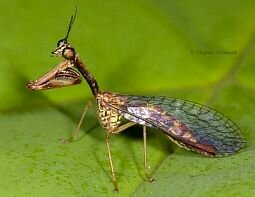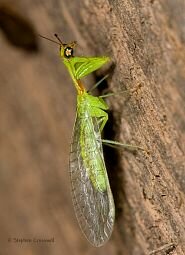Eric Eaton writes, "Mantisflies resemble a science experiment gone horribly wrong. Imagine shrinking a praying mantis, then attaching its front end to the hind end of a lacewing, and you have a mantispid."
Cannings and Cannings, writing in 2006, agree that the resemblance between Mantisflies and Praying Mantises is striking. Still, the Cannings remind us that the two insect groups are not really very closely related, and that the two groups independently evolved the triangular head on a stalk-like neck, the huge eyes, and the raptorial front legs. In other words, it is a case of convergent evolution. One sure reminder that Mantisflies and Mantises are not closely related is that the former undergo complete metamorphosis, including pupation, while in the latter group the immatures resemble small adults.
There are three subfamilies in the Nearctic, of which two are found only in western states. Mantisflies found in West Virginia and elsewhere in the East are in subfamily Mantispinae, and as larvae all are parasitic on spiders.
Click on a thumbnail to see a larger image and more information
|
|
Insects of West Virginia



